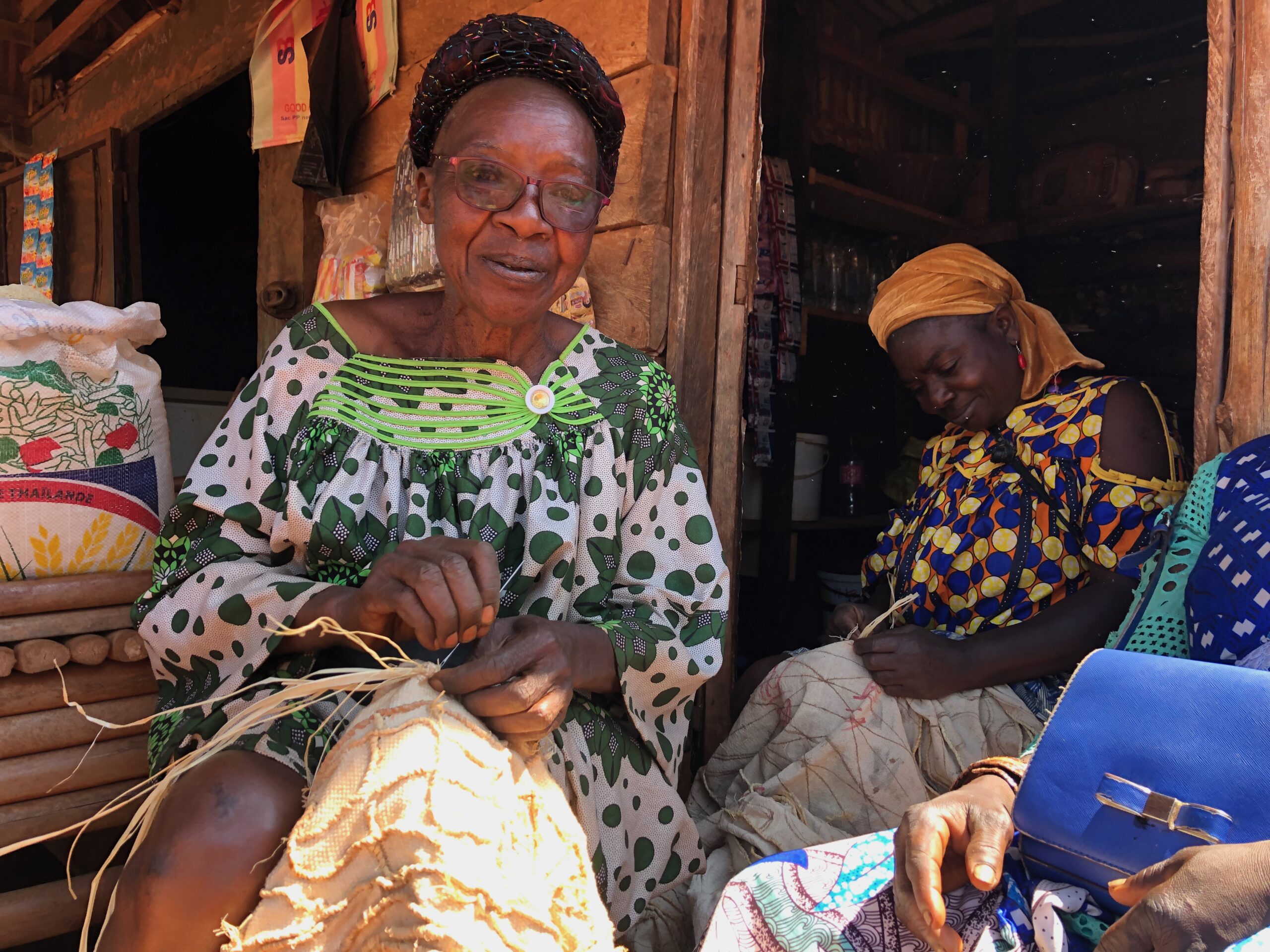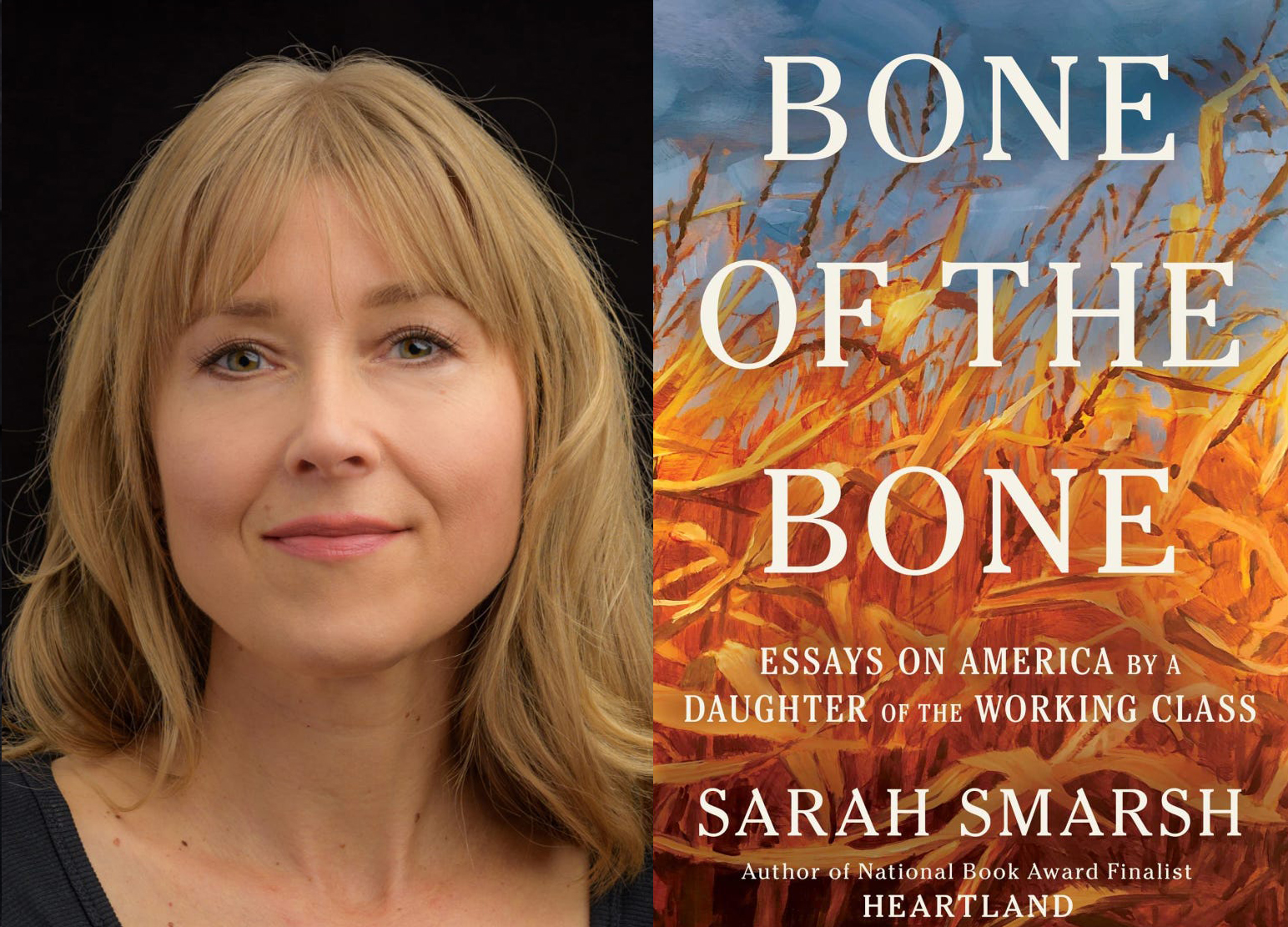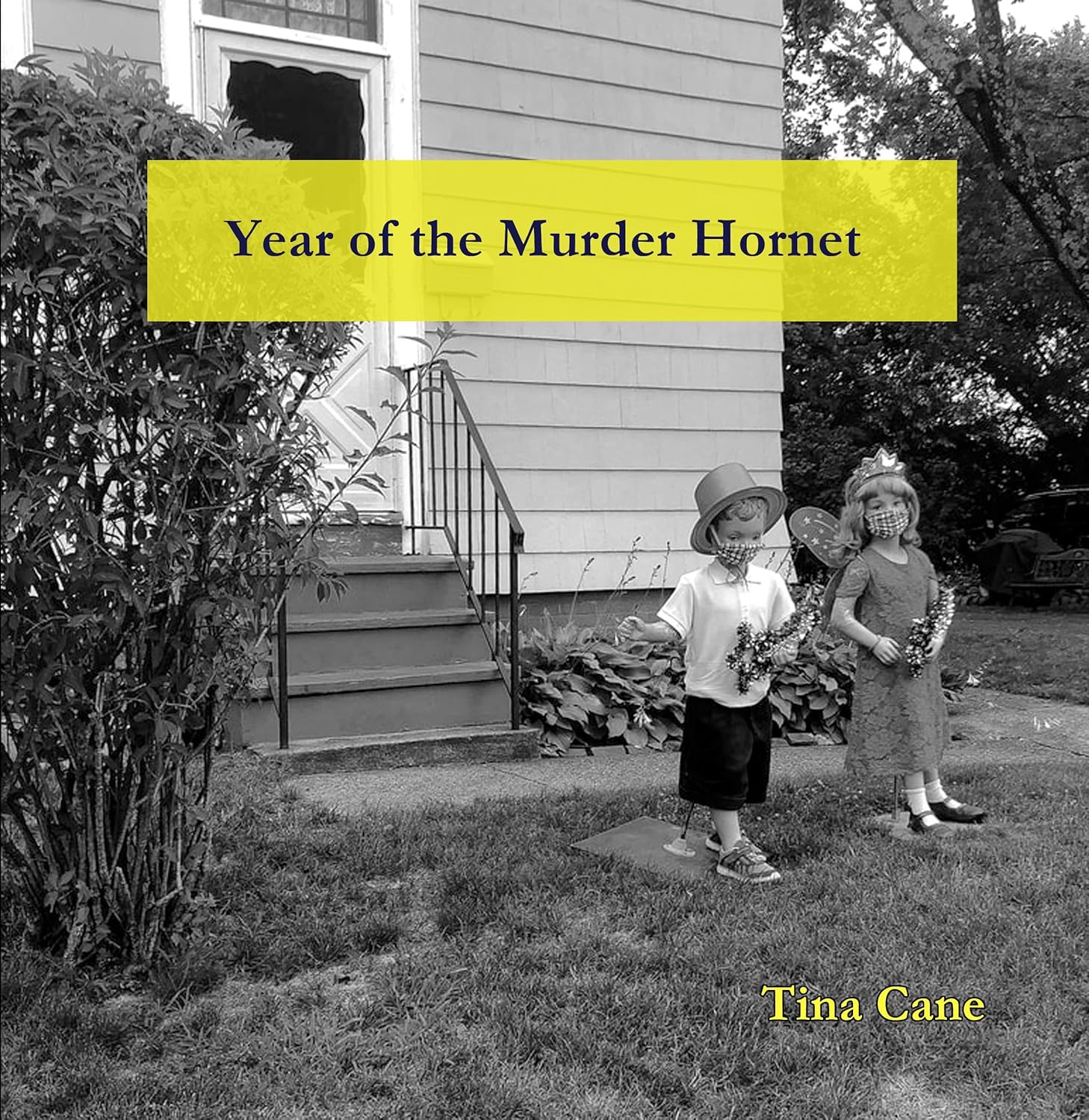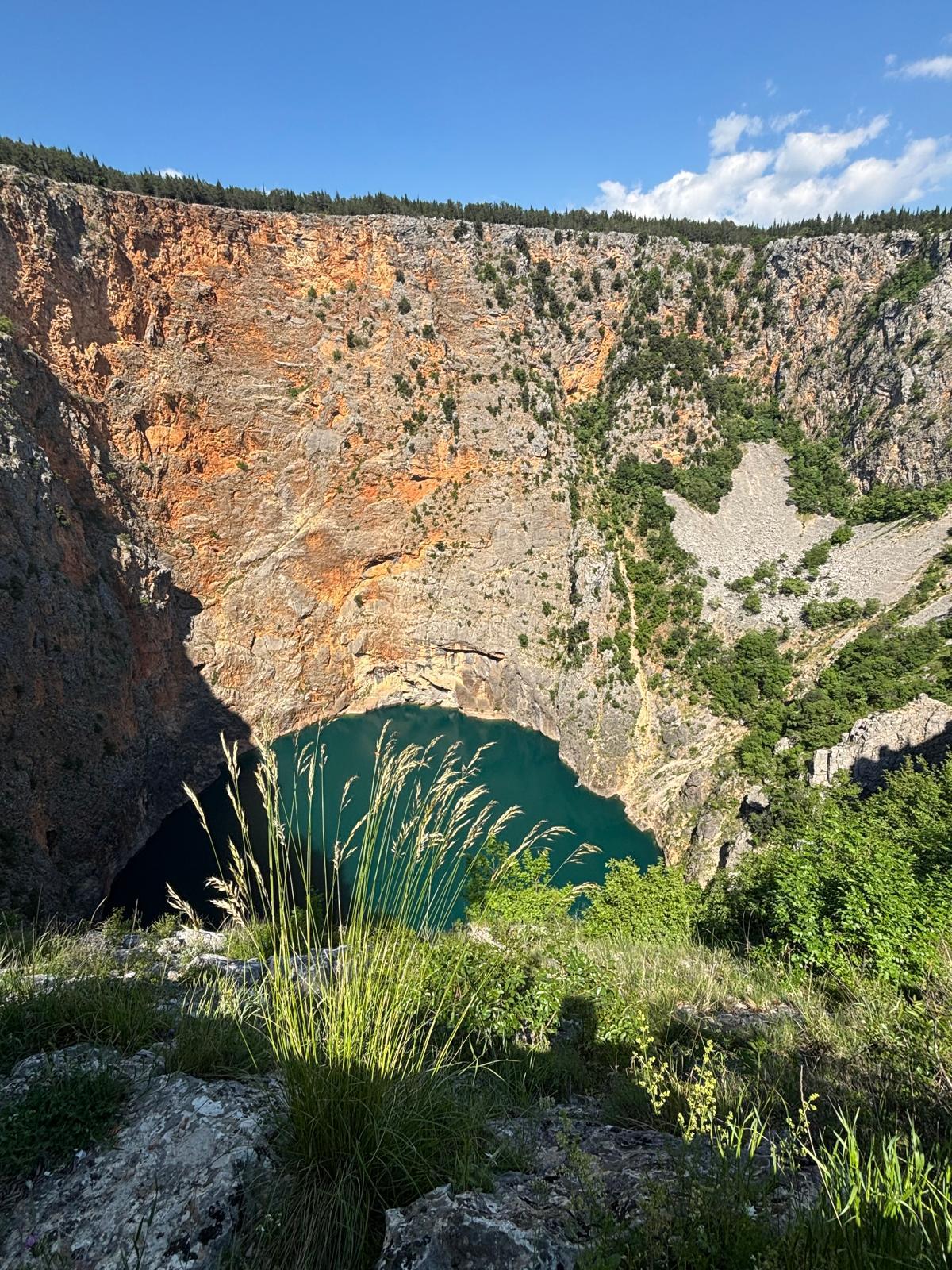The man’s face is gone. Gone the others circled around him in the hut, gone the clang of cowry shells (were they cowry shells?) gathered around their ankles, gone the hut. Gone the ochre-red soil on which the hut was built. All that’s left is the fabric the man, who was a chief, was wearing. The blue of it—a blue so rich it throbbed.
Indigo doesn’t just dye a surface. It gives depth.
This cloth was not an unbroken field of blue (astonishing blue). Parts of it had been left undyed, tracing white-on-blue diamonds, dissected circles, rows of chevrons and intersecting crosses in uneven but harmonious lines, which seemed to bloom organically across the chief’s blue cotton. And the cotton!
Its fibers were coarsely spun—the delightfully nubby texture of the handmade, which would have been flattened by the camera of my made-in-China-for-African-markets cell phone back then. So I have no pictures, and memory has erased all other details of my first encounter with the ndop cloth.
It is the fabric that has floated, context-less, seared in my mind.
At the time, I didn’t understand anything about the initiation ritual I was witnessing, and I’ve since forgotten exactly where it took place—only that it was in the Cameroonian Grassfields, somewhere near Bandjoun, where my then-boyfriend and I had lived for three years for his work. The village’s name likely began with Ba-, which in the language group Ghomala’ means “the people from …”: there is Bandjoun, Baham, Batoufam, Bafoussam, Batié, Bangangté, Bangoulap, Bafang, and Bazou, to name a few.
The Grassfields, a verdant, mountainous area that stretches across the francophone West and anglophone Northwest Regions, is home to the Bamiléké and the Bamoun. Among the 250 ethnic groups in Cameroon, they’re known for having preserved their traditions throughout the violence of colonialism and the war for independence. The Bamiléké are primarily Christian, and the Bamoun Muslim, but both practice religious syncretism, mixing imported faiths with indigenous beliefs, in which art holds a sacred dimension. Each piece of art has a function, providing material support for a complex matrix of rituals and socioreligious practices. In the Grassfields, art objects encompass both physical and spiritual dimensions—none more emblematically than ndop.
But depending on whom you ask, the indigo resist-dyed cotton might be called ndap, dze ndouop, nji ndop, ntie’yā, or akya. The cloth crosses administrative, ethnic, and linguistic borders, which makes talking about it in the singular case tricky. Whose ndop (or ndap, dze ndouop, nji ndop, ntie’yā, or akya) is being described? In which village’s rituals is it being worn? Given the rich variations between ndop produced and used by the Bamoun and that by the Bamiléké, the patterns of this cloth—though immediately recognizable—resist taxonomy. And what to do with the very term Bamiléké, itself a colonial deformation?
The story goes: near Mount Bambouto, a German colonial official asked his guide, from a town called Bali, the name of the people in this region. According to the Grassfields custom of referring to their neighbors based on their relative altitude, the guide responded in the Bali tongue: “those who live below.” This expression, mbalekeo, became, in time, Bamiléké. Today, the term is standard, often used without second thought, but embedded in its history is the concept of relational existence.
Ndop’s symbolically dense motifs also gesture to relationality. The fabric’s distinct geometric vocabulary contains a multitude of meanings about the relationships between humans on the one hand, and nature, royal power, and the invisible realm of the ancestors on the other: “a veritable book wherein we decipher numerous messages,” according to the Cameroonian art historian Jean-Paul Notué. This cloth shared by the Bamoun and the Bamiléké is both royal textile and religious text—and embodies the tension between tradition and modernity.
Five years and two continents after my ex and I left Cameroon, I went back for a month to study ndop. This return felt inevitable. In the interim, I’d developed overwhelming obsessions with both Grassfields traditional beliefs and the art of weaving.
My fixation on the former began shortly after leaving Bandjoun. I was in part seeking clarity on everything that I’d seen without understanding: the initiation rites, goat sacrifice, traditional architecture, sacred sites. Back then, I was unaware that another reason compelled me, though it’s never far from my mind.
My mother died at the age of thirty-seven. I was three.
I have no memories of her, and her absence has exerted a centripetal force on my being. It’s clear to me now that I devoured every text I could find on Bamiléké ancestral worship and animism because I’ve known my mother only through the kaleidoscopic assemblage of others’ memories and the objects she left behind. The attempt to comprehend Grassfields traditions—a constant back-and-forth between oral histories and material culture—so mirrored my personal search to know my mother that, by the time I returned to Cameroon, I thought that in understanding ndop, I’d finally learn how to grieve.
My fascination with weaving was born simply: I sat down at a loom and fell in love with the language of threads.
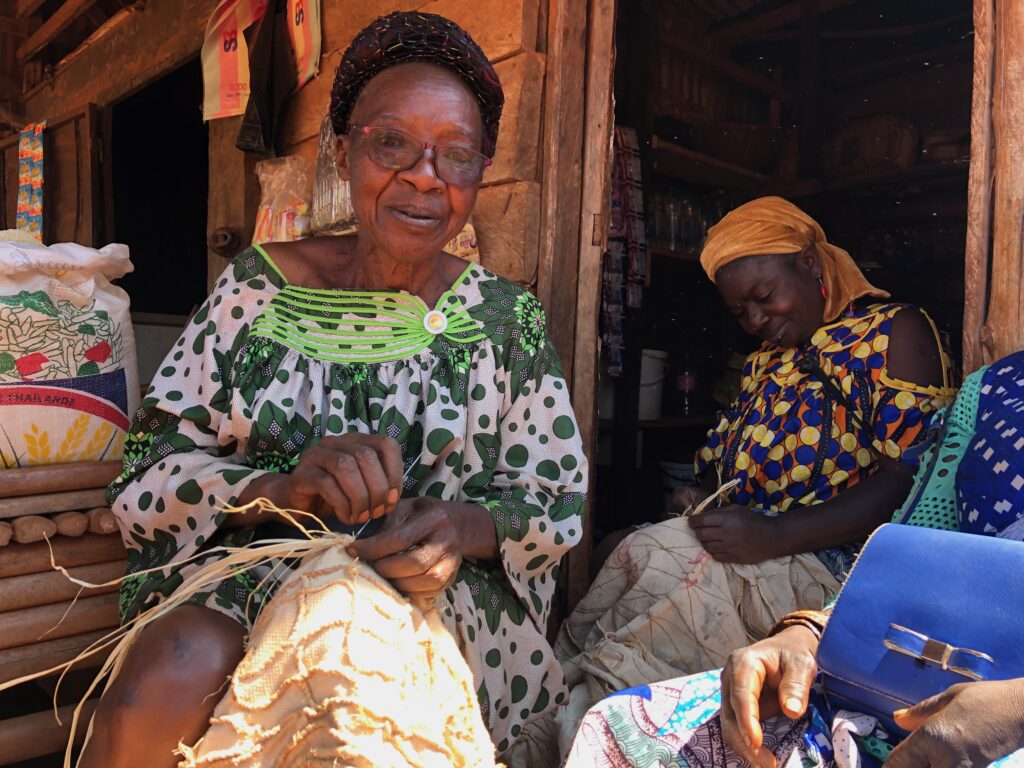
Christine Fiako (left) and Justine Mapa (right)
Historically, the making of ndop involved a generations-old collaboration between different ethnic groups throughout the country. Cotton cultivated and spun in the Extreme North was woven in Garoua, in the North Region, then sent to the Grassfields, where artisans traced the patterns with soot ink and stitched over them with raffia. When the cloth traveled back to Garoua for its indigo bath, the tightness of these palm-leaf stitches resisted the dye. Finally, it returned to the Grassfields, where the raffia threads were cut off. It was a labor-intensive process entailing over 2,500 kilometers of travel over the course of a year, and the price of six meters of cloth reflected this: around 120,000 CFA, or 180 euros.
Two rows of ndop costumes displayed in the Royal Museum of Baham, a current site of Bamiléké production, offer alternative versions of the textile. There’s a turn-of-the-century ndop made of jute, another that bears no symbols at all, a near-black monochrome dyed with a bygone technique of burying it in the marsh’s mud for a week. Simplified forms of the traditional patterns appear on the neighboring cloth, expanded in complex arrangements in the next. Here we see the divergent branches of material history—a reminder that tradition is not static.
That odd sensation of having stared at something for so long that I’ve lost the ability to see it. If all of these varied cloths are ndop, what is—or isn’t—it? As evidenced by the patternless, monochrome version of ndop in the Royal Museum, ndop existed as a textile before the symbols were set upon it. Inversely, the symbols themselves predate the fabric. Prior to the end of scarification practices, these ancestral patterns were embedded in royal women’s skin.
There’s no uniform interpretation of what ndop symbols represent. The major and minor differences between neighboring villages prove an endless well. Not contradictions, but highly localized specificities. Each kingdom brings its own nuanced understanding to the cloth, as diverse as the languages spoken from village to village.
He is called fon among the Bamiléké in the anglophone Northwest, fo, fù, nuifi, or fong by the Bamiléké in the francophone West, and sultan among the Bamoun. In the Grassfields, an ancient mosaic of sovereign kingdoms transformed into chiefdoms by colonial administrators, the chief is revered as the closest living person to the ancestors. The royal cloth of ndop, though also worn for other rituals, is the funerary attire par excellence. Funerals, here, are joyful reunions with the deceased, marking their transition to the realm of ancestors.
A funeral, I read, “shatters the grieving.”
I can describe a single ritual, such as a funeral, but doing so can’t encompass the whole matrix of beliefs. To speak of ancestral worship in French or English has felt like throwing darts at a bull’s-eye in constant motion: the words cluster around meaning, the accumulation gives an approximate location, but neither language can touch the center.
The time between my leaving Cameroon and my coming back was marked by an all-consuming search to find out who my mother was. Part hunt, part haunting; brisk illuminations and bouts of despair. The impossibility of knowing her through others’ time-dimmed portraits and the stories that her objects tell. (If they do tell stories, it’s with the same method as memory: by means of a generous dose of invention.) I struggled to resolve the conflicting descriptions of those who knew her. And yet there was clarity, too, in realizing how we are different things to different people.
To understand my mother through the material world and others’ memories. To understand Grassfields ancestral worship and the afterlife through ndop. By the time I returned, the two processes were entwined in my mind.
In Baham, packed dirt paths branch from the single asphalt road, heightening the region’s striking contrast between its ochre-red soil and abundant greenery. I’d visited Baham once, years ago. Though it’s less developed than Bandjoun, where I’d lived, and is serviced by only a single Total gas station, the scenery felt familiar: brick houses topped with corrugated metal sheeting, nine conical roofs at the entrance to the chiefdom, clusters of stalls selling everything from rice to Nido milk powder to tomatoes. What distinguishes Baham from its neighboring villages is that, at any given intersection, you’re bound to stumble upon a woman—or, more often, several women—stitching long strands of raffia thread through undyed cotton.
Perhaps “thread” is misleading; it feels more like pliable straw. Raffia fibers aren’t spun, like cotton or flax, but harvested from the young leaves of the palm tree, peeled apart, and dried in the sun for several days. Raffia grows in the tropical marsh, a densely green, miry belt that winds through the valleys and harbors the area’s most venomous snake. Every woman I would meet told me she and her children harvest raffia either first thing in the morning or in the evening, when the green mamba is resting.
“My grandmother warned me never to go to the bas-fond, the marsh, at midday,” Albert Fomkong Nkam, a co-conservator of the Royal Museum of Baham, said.
We were standing by a sculpture of a snake coiled on the ground. Albert took my arm and led me in front of a black-and-white photograph of the snake’s sculptor, a village elder. Albert’s grandmother had told him that if he went to the marsh around noon, he would encounter this sculptor.
I leaned in to read the caption. The sculptor was a notable, a royal dignitary, as is often in the case in the Grassfields, where art production is in service of the chief.
“I didn’t understand what my grandmother meant,” said Albert. “But, because I was an obstinate boy, I went.”
I could sense where the story was going. Central to the Grassfields’ socioreligious structures is the concept of totemism—that certain men of power (and a few women) incarnate specific animals. The pact between individual and animal, known as pi, gîe, or mepi, translates to “double in company.” To be here, in the hut, and also there, in the bush.
“Did you see the mamba?” I asked.
“He saw me first and slid down from the tree,” Albert said, mimicking the movement of the snake with his full body. “He stood up to face me and looked me straight in the eye.”
By this point, Albert was holding my shoulders in a tight grip. Neither of us spoke. In the museum’s subdued light, time sputtered to a halt—as it must have for the boy years ago, facing down the snake or the village elder, depending on what one believes.
Albert waited until I broke the silence to tell me what happened next. The threat lost interest and slinked away. After the artist in the photograph had died, Albert found the sculpture of the snake and understood it to be a self-portrait.
Ask a question about raffia harvesting, and you might land on totemism. It happened often throughout the month I spent traveling through the Grassfields: tugging on a single aspect of ndop would lead to another thread in the local cosmology.
Referred to as living museums, chiefdom treasuries in the Grassfields, such as the Royal Museum of Baham, rarely display the kings’ collections under glass cases. For initiation rites or biannual village purification ceremonies, the carved masks, stools covered in cowry shells, beaded calabashes, and textiles are removed from the museum and animated. These are king things; one must be a member of a secret society or the royal family to use them.
It seems tricky—how can the tradition be sustained, and how do ndop artisans gain their livelihood, if only a small segment of the population can wear the fabric? Albert reminded me that ndop doesn’t always have to be shaped into a garment. In funerary rites like the Khaadze, families display a bolt of ndop in the courtyard. The longer the cloth, the more prestigious the family. There’s also the growing demand among the diaspora, where prohibitions aren’t always followed, which has driven up prices. I’d seen ndop hung in the storefronts of Chateau Rouge in Paris; not only a ritual object, it now serves as a marker of cultural identity.
“But anyone from Baham who isn’t a dignitary knows not to set foot in the village wearing it,” Albert said as he accompanied me out of the chiefdom to find a moto-taxi. It was early afternoon, when air weighs on the body like a lead blanket. We were plodding up a steep dirt path called l’axe de la vie, “the road of life,” which connects the royal palace to the market.
Distracted by the heat but comfortable with this man, a walking encyclopedia with an easy smile, I suddenly recalled something I’d read in another village’s museum. In the spatial organization of Grassfields chiefdoms, the market is considered the meeting place of all the forces in the realm of the living and the realm of the dead. This memory joined a line from a novel by Teju Cole: “One goes to the market to participate in the world.”
Commerce and spirituality—I’d always thought of them as antithetical. Always considered the latter immaterial. But when a member of the secret society Kuo’si wears an ndop tunic with the elephant mask, he transcends himself. Contact with the cloth puts him in contact with the invisible: the realm of spirits, forces, and ancestors. Ndop is as much a physical object—matter worked and sublimed by different hands—as it is a vehicle offering a relationship with the cosmos. One can’t unravel its dual identity. The histories of textile traditions are also histories of trade, influence, and cultural exchange. Geopolitics condensed in cloth. The problem isn’t that ndop is a contradiction—both a commodity sold in the market and something sacred, set apart. The question instead is: How, with the frenetic clip of commerce in globalized modernity, can ancient knowledge persist?
My thoughts had hurried my feet. I relaxed my pace to match Albert’s. We reached the top of the hill where the road of life ends. When I turned around, my eyes landed past the palace on the chiefdom’s forbidden spaces: the grand hut where the Council of Nine meet, the sacred forest where kings are buried.
For as much as Albert and other cultural stewards shared with me, there’s a limit to what one can understand about these rituals without being initiated into them. It’s a lifetime of learning. And though Grassfields traditions have been extensively documented, there’s an understandable protectionism around them.
Parallels abound across the globe—painted barkcloth in the Pacific, for instance. In Vanuatu, the island nation west of Fiji, missionaries removed so much of the material culture of the Erromangan that local chiefs instructed their people to paint their histories on the walls of secret caves so that, should it all disappear, future generations would know the people and gods of the island. The barkcloth tradition was lost for a century until the beginning of the millennium, when islanders traveled to the Australian Museum to see the largest early Erromangan barkcloth collection. From these visits, they were able to restore the practice of making barkcloth. And the caves—they still exist, their walls still painted, and they’re still secret, forbidden to outsiders.
Just focus on ndop, I told myself. Don’t try to grasp all of the mysteries.
As I was leaving Baham on the back of a moto-taxi, a flash of deep blue caught my eye as I winged by a stand where a woman sat, blocking the dyed cloth with her foot to hold it taut on her lap. She flicked a knife over the raffia, making small, quick incisions to reveal the white underneath.
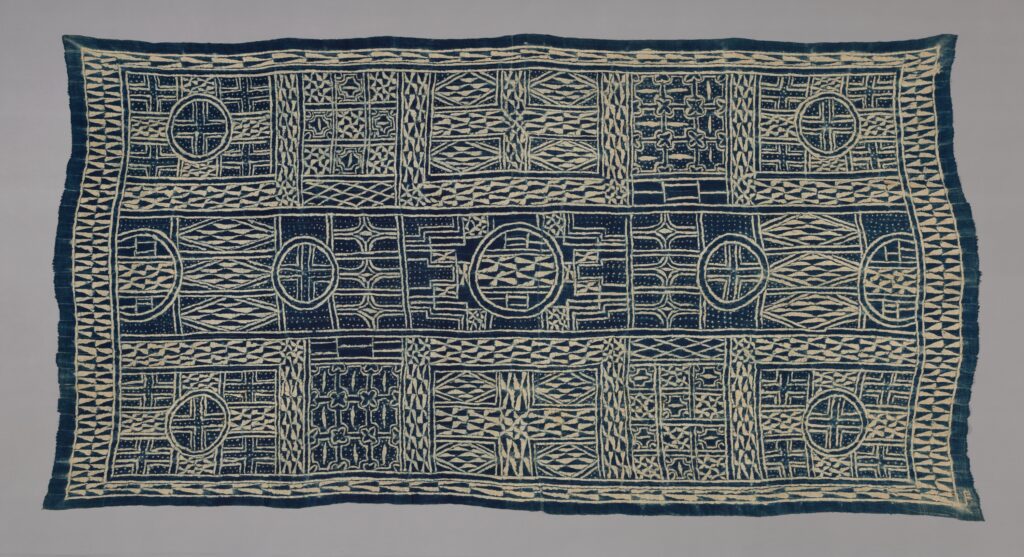
Ndop Display Cloth, early/mid–20th century. The Art Institute of Chicago.
The next day, I boarded a coaster bus to Foumban, across the Noun River, which divides the Bamiléké territory from the Bamoun. I’d been told that the cotton base for ndop, no longer sourced from the northern regions, sometimes comes from Bamoun weavers. I’d received many conflicting versions from the Bamiléké of how the cloth is made and used today. I needed to hear Bamoun perspectives on the contemporary process of its making. Even as I pursued the pragmatic approach of following the tangible means of production, what I really wanted to know was what the cloth means. The ways in which this question had been answered both in texts I’d read and in conversations, which usually circled around the various significations of motifs, had left me perpetually dissatisfied. As with descriptions of my mother from others, I couldn’t shake off a sense of incompleteness.
My resolve hardened on the bus. I’d track the material. I’d stick to the physical world, and maybe, just maybe, illumination about the intangible might glint from the weave.
Upon arrival at the sultan’s palace, I called the woman I was to meet. She instructed me to find a moto-taxi driver to take me “where they weave cloth.”
“It’s behind the old prison,” she said. “They’ll know where it is.”
The bendskinner nodded, but as we left the city limits, I began to suspect he did not know. In retrospect, I can see both the humor in our hour-long zigzag through Foumban, continually pointed in opposite routes when asking for directions, and how it foreshadowed the following weeks. What I thought would be fairly straightforward—arriving at the weaving center, tracing ndop’s contemporary production—proved full of detours and contradictions.
When I finally reached Honorine Mboum’s family compound, she led me to a dark workspace filled with vertical looms made from wooden sticks and raffia stems. A bare lightbulb hung from the ceiling, more decorative than functional in the dry season’s frequent power outages. I watched a woman winding metallic warp threads directly onto the loom. I didn’t want to disturb her, knowing from experience how easy it is to lose count. Hip-hop leaked from the adjoining room, where a young man named Abou sat by an open window, weaving a navy blue fabric accented by thin red stripes. He learned the trade when his family could no longer pay for his education. The time passed quickly, he said, when he listened to music. Sometimes he’d bring the loom home for his siblings to help him work on it. Abou continued weaving while answering my questions; he gets paid by the project. I could feel Honorine hovering nearby as I asked about his wages.
“All done,” she didn’t ask so much as announce.
I followed her into what doubles as living room and showroom: two large couches, a TV, and wall-to-wall shelves stacked with folded fabrics. Honorine, who describes her work as preserving an endangered trade, explained how her father created the center, which existed as a nonprofit trade school until a few years ago, when she transformed it into a business. She scooped up her youngest son, who’d just toddled into the room in a checkered school smock. It’s a family affair, she continued: every person living in the compound contributes to the textile production, including the children and the many women who’ve married into the family. (Polygamy is legal and widely practiced in Cameroon.)
Pulling a cloth from the shelf, she showed me her label: Ngâme Productions. In the Bamoun dialect, ngâme means “spider”—a symbol for both wisdom and ardor.
“Cameroon is like a spider, which produces everything it needs to weave its web.”
I looked at the library of fabrics in bright hues, many woven with metallic fibers.
“What about the dyes and the synthetic threads?” I asked.
“We get the yarn from CICAM,” she said, referring to the Industrial Cotton Company of Cameroon, one of the two major players in the country’s textile industry.
The ideal of the spider disintegrates upon closer inspection: CICAM imports its dyes and much of its cotton, too. In 2020, CICAM merged with SODECOTON, the state-owned company responsible for regulating and promoting the cotton industry in Cameroon, but the vast majority of cotton produced by SODECOTON is exported. As is too often the case across Africa, raw material of the finest quality is sent elsewhere, and cheaply produced cloth takes its place.
Even if ndop didn’t carry interdictions around who can wear it, the time-consuming nature of its making would keep it from being fully democratized. Ndop can’t serve as an antidote to globalization and the textile trade. However, its historical production—the collaboration between people of different regions—resonates with Honorine’s image of the self-sufficient spider, even if today’s ndop is no longer produced in this way.
I looked around the showroom. Warp-faced fabrics with colorful stripes filled the shelves. It seemed that most of the textiles made by Ngâme Productions had nothing to do with the traditional cloth. When I asked about ndop, Honorine opened a cabinet holding undyed cloths commissioned by Baham artisans, who would then draft the patterns onto the cotton she’d woven.
“We make ndop here, too,” she said, pointing to a blue cloth covered in raffia threads not yet cut off.
“Can anyone wear this?” I asked. “Or is it reserved for royalty?”
“Anyone who buys this can wear it,” she said. “This is a Bamiléké design. It’s a simplified pattern.”
For Honorine, Bamoun patterns originated the Bamiléké ones, which in her mind hold no sacred dimension. She reached into a drawer and pulled out a Bamoun ndop cloth she called “complete,” featuring an array of tightly grouped motifs that broke across the fabric in columns and crosses. The design was organic yet ordered, a densely packed harmony of grids and curved lines. She’d encouraged photographs of her workshop, but when I asked if I could document this fabric, she shook her head.
“My brother posted his design on Facebook. Later we found it copied in the market.” She showed me pictures of his textile and the imitation, an industrially wax-printed cotton known locally as pagne. “We don’t have the resources to protect our work.”
Ndop’s symbols are everywhere in the Grassfields—painted on storefronts or on the walls of chiefdoms—but they appear most frequently on these imported wax-printed pagnes. They’re both significantly cheaper and authorized for the general public. Apart from Honorine, all of the other artisans I spoke with insisted that authentic ndop, worked by hand, can be worn only by kings, queen mothers, or dignitaries.
I left Foumban in a coaster bus—one of those rickety, compact models where five or six people occupy a bench designed for four. The engine gave an exasperated sputter near the Noun River, the boundary between the Bamiléké and the Bamoun. It’s a porous border: the landscape mirrored on either side of the river, both groups present in each other’s territory. The bus groaned and slowed to a crawl. To distract myself from my nerves crackling over the fear we’d arrive after nightfall, I settled into the door handle I’d adopted as an extra rib and sifted through the day’s notes.
Honorine’s claim jumped out at me—that the “simplified patterns” she’d shown me are Bamiléké, democratized because they’re derivatives of the more complex Bamoun ndop. The two groups waged intermittent wars well before European arrival in the region. Throughout the nineteenth and twentieth centuries, colonial administrators exploited ethnic tensions as a tool to solidify their authority. Today, the sense of belonging to one group or other often manifests in a disconcerting assertion of supremacy. Honorine wasn’t the only one to give me pause. Bamiléké artisans insisted that Baham is the singular, authentic center of ndop activity, though Foumban’s royal court and other Bamoun workshops produce the cloth as well.
To whom does this textile belong? Why the concerted effort to preserve this tradition and not, say, the barkcloth of Cameroon’s East Region?
The bus lurched into Bafoussam at the day’s final light. I felt not the relief I’d expected, but a deep sense of unease.
Though it’s possible to distinguish between ndop made by the Bamoun, that of the Bamiléké in the francophone West, and what comes from the anglophone Northwest, no evidence suggests that any one originated the others. All of these variations likely developed from Nigerian wukari. The first written account of their differences—distinct geometric designs, a privileging of certain patterns—came to me through Ly Dumas. The daughter of Bamiléké royalty, she established a career in high fashion, married into the Hermès fortune, and founded an NGO in her father’s native village. (I myself studied there for a sewing certificate.) The Jean-Félicien Gacha Foundation and its sister organization in Paris are at the forefront of the movement toward international recognition of ndop and its inclusion on UNESCO’s Intangible Cultural Heritage list. They host roundtable discussions, collaborate with cultural institutions, and release publications like the one devoted to ndop. In the book’s introduction, Dumas asks: “And what if a fabric alone could tell the whole history of a people? And what if it could guide those who wore it in this life as well as in the next?”
It’s a beautiful book—a long, rectangular format with foldouts displaying remarkable examples of ndop from Dumas’s private collection—but nowhere does the text acknowledge what’s obvious to even an untrained eye. Most of what’s produced in Baham today is, indeed, simplified: uniform in its design, displaying the same four motifs arranged identically. It’s the double-edged sword of preservation efforts. Promoting the artisanal cloth internationally has pushed the handmade into the logic of mass production. Produce more, and produce it quickly. Don’t innovate; don’t invent—copy.
“We never vary,” Ismael and Stella, two pattern-drawers in their mid-twenties, told me. Descendants of Kamwa Simo, the near-centenarian patriarch of Baham’s preeminent ndop-producing family, the cousins described the rationale behind the ordering of ndop symbols.
“It’s like the alphabet,” Ismael said. “A, B, C. One pattern must follow the other.”
“But wouldn’t you want to mix up the letters to make words?” I asked.
Stella shook her head: “It is always the same.”
“This is not art,” Pascal Tadjuidje, one of Kamwa Simo’s sons, added. He drew a distinction between what he produces serially for the market and pieces commissioned by royalty, in which he varies the design and includes particularly potent symbols.
“But all of this is ndop,” he specified. “It’s reserved. The more powerful person gets more powerful patterns is all.”
Pascal told me his family no longer sources the undyed cloth from the northern regions, nor from Foumban. They rely primarily on cloth woven either industrially or by hand in China. The wars throughout the Sahel have disrupted the ancient indigo routes, so they’ve learned to dye ndop themselves, using synthetic colorants of unreliable quality imported from Nigeria. Resist-stitching with raffia thread—work the family often outsources to the women of Baham—takes too long, he said. He’s interested in how the process could be modernized.
From Moroccan embroidery to hand-weaving in Upper Egypt, there’s a surging effort to preserve global textile traditions—work I’ve applauded for years from a distance. How easy, at a remove, to admire the richness of a handcraft, the painstakingly slow know-how transmitted from generation to generation, and forget the reality of the makers, not all of whom are as attached to the old ways.
Cotton, raffia, indigo. Of the three materials traditionally used to make ndop, only the raffia comes from the same local source as generations ago. But the raffia disappears from the final product. Resist-dying is a process of mark-making through removal; the raffia is stitched over the patterns and cut off after the dye bath. What’s seen on the cloth is where the raffia once was—the trace it left behind, the presence of its absence.
I decided to return to the center of Bamiléké ndop production and rented a room in the Baham chiefdom for the remainder of my time in the Grassfields. Beyond ndop’s use in funerary rites and what its patterns represent, the relationship between cloth and cosmology still eluded me. I was convinced that those closest to the material, who work it with their hands, must be in a privileged position to speak to it. I’d held onto the hope that they would tell me how their craft connects to their beliefs about the afterlife.
In the slow, hot days of the dry season, my days settled into a routine, rhythmed by long walks in which I stopped to talk with women I met along the way, returning the next day, and the next. At an intersection a kilometer from the chiefdom, Justine Mapa and Christine Fiako sat on stools in the shade of Justine’s small commerce, stitching raffia. Friends from childhood who’d spent their adult lives apart from one another, they now worked together, anticipating each other’s needs—a fresh thread of raffia, change for a customer—in that wordless communication of familiar company. Inspecting the cloth she was working on through her pink-rimmed glasses, Christine explained that she had followed her late husband to Douala, the major port city. Last year, the city’s rising prices forced her to close her shop, and she returned to her native village, where she could work in the fields and on ndop. Justine’s mother had taught her to stitch, and she taught Christine. The two of them taught me. I worked a corner of cloth throughout a morning, making incremental progress. They told me they’ve both transmitted the skill to their children, but only, they’re careful to say, as backup. If they can’t find a job after their studies, they’ll always be able to make money doing this, Justine said. But there’s too much competition: all of the women in Baham stitch raffia. The pattern-drawers set the prices, and the women who spend their days working the ancestral patterns do so for a paltry sum: 10,000 CFA (fifteen euros) for over a month of work. It’s a purely commercial venture, a second profession that subsidizes their labor growing crops or selling goods.
When I eventually asked what the patterns mean to them, Christine and Justine said this is not their domain. It doesn’t concern them. They insisted they’re not allowed to wear ndop, and the conversation screeched to a halt. Maybe I’m asking the wrong questions, I thought. Or maybe language, like memory, is a sieve; certain finer points are constantly escaping it.
I learned to ask instead: Are you a traditionalist?
Julienne Pokam’s knife glinted as she flicked it over raffia, a gesture her hands have carried out for half a century. “Of course,” she answered. On the topic of rooster and goat sacrifices, she said, “I like to call them little parties.”
She paused to pick out an errant thread.
“If my mother were alive, I couldn’t pass by her house without saying hello.”
Her words sent a shudder through my breath, dislodging a tight coil of grief—so often evoked as carried in the heart or gut, but it’s not—at least, not for me. My grief has been caught in my throat.
All along, I’ve thought I could move through mourning by learning who my mother was. The question shifts: how to talk not of but with.
In Grassfields cosmology, at the farthest reach of an unbroken line of generations—the unfathomable end of infinity—there is a Supreme Being, but it is one whom the Bamiléké never address directly. Their ancestors act as intermediaries. The word for “God” in Bandjoun and Baham, sì, is the same as for “ground,” and that is where I’ve seen believers look when referencing the divine—not up to the sky, but down to where their lost ones are buried.
To speak with someone no longer living is predicated on the belief that they’re still present. That an invisible realm surrounds the visible, and a line of communication can be opened between them. In the Grassfields, tradition is seen as a burden, a responsibility to maintain the continuity between generations. Tradition is the “speech” of the ancestors. Through a sequence of gestures—after three years of mourning, the living exhume the skull of the deceased, wash it with palm oil, and place it among others in a house of skulls—the dead dwell in the present tense.
This conception of the dead’s place among the living has seeped through my thinking. Before, I’d thought that the work of mourning was to fill the hole left by a loved one’s death. But to cultivate a relationship with the dead—what I am attempting to do with my mother—is to address that space directly. I’ve felt my mother’s absence and, through it, her presence.
Back at the Royal Museum, Albert pulled a pair of chairs to face each other and gestured for me to sit.
“Every one of ndop’s patterns relates directly to this connection with ancestors,” he said. On his forearm, he traced ndop’s diamond form, which I’ve alternately heard described as a representation of a crocodile, a symbol of royal power, and an emblem of fertility. He presented it as a mnemonic device. As his finger hit each corner, he said a word in the Baham tongue. Four things he asks of his ancestors: health, longevity, wealth, and progeny.
“When I bring my sons to a sacrifice, they have no patience for the ritual itself,” Albert said. “What is this old man doing with his palm oil and peace tree branches? they ask. All they want is the goat meat at the end.”
He sees a double threat: the younger generations’ lack of interest in tradition and the reduced quality in the cloth’s material and design. Ndop’s current production, with its mechanical repetition of motifs, strangles the innovation needed for the patterns to exist as a living language.
“It’s going to take some sort of cultural revolution to revive it,” he concluded.
Does he believe this will happen?
He leaned forward, straightening his spine away from the chair back. He wants to be hopeful, he said. He wants to. He sat perfectly still, as if to urge faith to settle upon him, that sliver of space between his body and chair: a mirror to the gap between wanting to hope and hoping.
Reporting for this story was supported by the Pulitzer Center.
Lily Lloyd Burkhalter is a writer living in Lille, France. Her work can be found in Ploughshares, Gulf Coast, The Missouri Review, Denver Quarterly, and elsewhere. She is represented by Audrey Crooks at Trident Media Group. Fieldwork for her essay in this issue was supported by the Pulitzer Center on Crisis Reporting.
